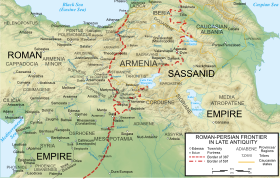قباذ الأول
| قباذ الأول | |
|---|---|
| شاهنشاه الإيرانيين وغير الإيرانيين | |
 صورة قباذ الأول على أحد دنانيره. | |
| العهد | 488–496 (العهد الأول) 498–531 (العهد الثاني) |
| سبقه | بلاش، جاماسپ |
| تبعه | كسرى الأول |
| وُلِد | 473 |
| توفي | 13 سبتمبر 531 |
| الزوج | پيروزدخت (هي أيضاً شقيقته) نيڤاندخت |
| الأنجال | Kawus كسرى الأول Zamasp Xerxes |
| البيت | بيت ساسان |
| الأب | پيروز الأول |
| الديانة | الزرادشتية |
قباذ (الفارسية المتوسطة: kwʾt' Kawād؛ فارسية: قباد Qobād؛ إنگليزية: Kavadh I؛ عاش من حوالي 473[1] – 13 سبتمبر 531[2]) كان ملكاً ساسانياً على فارس من 488 حتى 531. وهو ابن پيروز الأول (457-484)، وقد توَّجه النبلاء على العرش بدلاً من عمه المخلوع المثمول، بلاش (484-488).
شهد عصره انتفاض ڤاختانگ الأول من أيبيريا، وكذلك الحرب الأنسطاسية والحرب الأيبيرية ضد غريمة الساسانيين، الامبراطورية البيزنطية المجاورة. وفي عهد قباذ، أنشئت استحكامات هائلة في القوقاز، منها دربند.[3]
النشأة وارتقاء العرش
وُلِد قباذ في 473.[1] بعد هزيمة الساسانيين الكارثية في معركة هرات، نجا عدد قليل من السلالة الملكية، حسب پروكوپيوس، من نحو 30 ابناً لـپيروز الأول. إلا أنه كان في الأسر لدى الهفتاليين، and was later rescued by the Karenid Sukhra, who managed to defeat their leader Khushnavaz. After this victory, Kavadh and Sukhra returned to Ctesiphon, where Balash was crowned as king of the Empire. However, in reality it was Sukhra who had control over the Sasanian Empire. Gushnaspdad, the kanarang of Abarshahr, urged the Sasanian nobles to have Kavadh executed.[4]
انتفاضة ڤاختانگ الأول

المزدكية
بينما كان الخطر يتهدد فارس من جهة الشرق، إذ ضربت الفوضى أطنابها في البلاد، نتيجة لاضطرار الملكية إلى الكفاح للمحافظة على سلطانها ضد الأشراف ورجال الدين. وفكر كفاده الأول (488-531) في أن يضعف أولئك الأعضاء بمناصرة إحدى الحركات الشيوعية، التي كانت تتخذهم الهدف الأول لهجاتها وتفصيل ذلك أن أحد رجال الدين الزرادشتيين المدعو مزدق قد أعلن في عام 490 أنه مرسل من عند الله للدعوة إلى عقيدة قديمة مضمونها أن الناس جميعاً يولدون أكفاء، وأن ليس لأحد من الناس حق طبيعي في أن يمتلك أكثر مما يمتلكه غيره، وأن المِلْكية والزواج من البدع التي ابتدعها البشر، وأنها أخطاء عاقبتها البؤس والشقاء، وأن السلع جميعها والنساء كلهن يجب أن تكون ملكاً مشاعاً لجميع الرجال. ويقول عنه أعدائه إنه كان يجيز السرقة، والزنى ومضاجعة المحارم ويتخذ هذه الأعمال وسيلته الطبيعية لمقاومة الملكية والزواج، ويقول إنها الطرق المشروعة للوصول إلى المدينة الفاضلة. واستمع إليه الفقراء وبعض الطوائف الأخرى مغتبطين، ولكن أكبر الظن أن مزدق نفسه قد أدهشته أن يجد ملكاً يوافق على آرائه. وبدأ أتباعه ينهبون بيوت الأغنياء، ثم لا يكتفون بهذا بل يسبون نساءهم أيضاً، ويأخذون أثمن ما في هذه البيوت ومن فيها من جوار ومحظيات حسان. وثارت ثائرة الأشراف فزجوا كفاده في السجن وأجلسوا أخاه جامسب على العرش. وقضى كفاده في "قلعة النسيان" ثلاث سنين فر بعدها من السجن، وهرب إلى الإفثاليين، ورأى هؤلاء الفرصة سانحة لأن يكون حاكم بلاد الفرس خاضعاً لسلطانهم، فأمدوه بجيش وساعدوه على أخذ طيسفون عنوة. ونزل جامسب عن العرش، وفر الأشراف إلى ضياعهم في الريف، وأصبح كفاده مرة أخرى ملك الملوك (499). ولما استتب له الأمر غدر بالشيوعيين، وقتل مزدق وآلافاً من أتباعه(39). ولعل هذه الحركة قد رفعت من شأن العمل اليدوي، لأن قرارات مجلس الدولة بعدئذ لم يكن يوقعها الأمراء ورجال الدين وحدهم، بل كان يوقعها معهم رؤساء نقابات الحرف(40). وحكم كفاده بعد ذلك جيلاً آخر؛ وحارب أصدقاء الإفثاليين وانتصر عليهم، وحارب روما حرباً غير حاسمة، ثم مات وترك العرش لابنه الثاني كسرى أعظم ملوك الساسانيين جميعاً.
الحرب على البيزنطيين
الحرب الأنسطاسية
 مقالة مفصلة: الحرب الأنسطاسية
مقالة مفصلة: الحرب الأنسطاسية
احتاج قباذ للمال لسداد ديونه للهياطل الذين ساعدوه في استعاده عرشه، and he applied for subsidies to الامبراطورية البيزنطية, which had before supported the Sasanians. But now the Emperor أنسطاس الأول (491–518) refused subsidies, which made Kavadh try to gain the money by force.[5]
وفي 502، استولى قباذ على ثيودوسيوپولس , perhaps with local support; the city was in any case undefended by troops and weakly fortified.[6] قباذ، مع Adergoudounbades, then besieged the fortress-city of Amida through the autumn and winter (502–503). The siege of the city proved to be a far more difficult enterprise than Kavadh expected; the defenders, although unsupported by troops, repelled the Persian assaults for three months before they were finally beaten.[7] The Romans attempted to recapture the city, but they were unsuccessful. Kavadh then tried to capture الرها في Osroene, but was unsuccessful.[8]
وفي 505 an invasion of Armenia by the Huns from the Caucasus led to an armistice, during which the Romans paid subsidies to the Persians for the maintenance of the fortifications on the Caucasus,[9] and in return for Amida, which was captured by Kavadh. The peace treaty was signed by Bawi, the brother-in-law of Kavadh.[10][11]
الحرب الأيبيرية
في 524-525 ، اقترح قباذ أن جستن الأول يتبنى ابنه الأصغر والمفضل لديه، كسرى، إلا أن المفاوضات سرعان ما انهارت. Kavadh then had Seoses, his negotiator, executed.[12] Hostility between the two powers erupted into conflict when Guaram I, ملك أيبيريا القوقازية، defected to the Romans in 524–525, after Kavadh tried to convert the Iberians to الزرادشتية.[13] Sasanian and Roman fighting then broke out in the Transcaucasus region وأعلى الرافدين by 526–527.[14] الملك التابع لقباذ، المنذر الرابع بن المنذر، دمر Mesopotamia وذبح الرهبان والراهبات.
نزاع الخلافة
Kavadh I was succeeded by his youngest son Khosrau I; however, at the beginning of his reign in 531, Bawi, along with other members of the Persian aristocracy, became involved in a conspiracy in which they tried to overthrow Khosrau and make Kavadh, the son of Kavadh's second eldest son Zamasp (Zames),[15] the king of the Sasanian Empire. Upon learning of the plot, Khosrau executed all his brothers and their offspring, along with Bawi and the other "Persian notables" who were involved.[11] Khosrau also ordered the execution of Kavadh, who was still a child, and was away from the court, being raised by Adergoudounbades. Khosrau sent orders to kill Kavadh, but Adergoudounbades disobeyed and brought him up in secret, until he was betrayed to the shah in 541 by his own son, Bahram (Varranes). Khosrau had him executed, but Kavadh, or someone claiming to be him, managed to flee to the Byzantine Empire.[16]
الهامش
- ^ أ ب خطأ استشهاد: وسم
<ref>غير صحيح؛ لا نص تم توفيره للمراجع المسماةiranicaonline.org - ^ http://global.britannica.com/EBchecked/topic/313506/Kavadh-I
- ^ One or more of the preceding sentences incorporates text from a publication now in the public domain: Chisholm, Hugh, ed. (1911). . دائرة المعارف البريطانية. Vol. 8 (eleventh ed.). Cambridge University Press. p. 64.
{{cite encyclopedia}}: Cite has empty unknown parameter:|coauthors=(help) - ^ Pourshariati (2008), pp. 268–269
- ^ Procopius, History of the Wars, I.7.1-2; Greatrex & Lieu 2002, p. 62.
- ^ Greatrex & Lieu 2002, p. 62.
- ^ Greatrex & Lieu 2002, p. 63.
- ^ Greatrex & Lieu 2002, pp. 69–71.
- ^ پروكوپيوس، تاريخ الحروب, I.9.24; Greatrex & Lieu 2002, p. 77.
- ^ Procopius 2007, p. 83
- ^ أ ب Pourshariati 2008, p. 111
- ^ Procopius, Wars, I.11.23–30
* Greatrex (2005), 487; Greatrex–Lieu (2002), II, 81–82 - ^ Greatrex–Lieu (2002), II, 82
- ^ Greatrex–Lieu (2002), II, 84
- ^ Frye 1983, p. 465
- ^ Martindale, Jones & Morris 1992, pp. 16, 276; Pourshariati 2008, pp. 268–269; Greatrex & Lieu 2002, p. 112.
المصادر
- Pourshariati, Parvaneh (2008). Decline and Fall of the Sasanian Empire: The Sasanian-Parthian Confederacy and the Arab Conquest of Iran. London and New York: I.B. Tauris. ISBN 978-1-84511-645-3.
- Greatrex, Geoffrey; Lieu, Samuel N. C. (2002). "Justinian's First Persian War and the Eternal Peace". The Roman Eastern Frontier and the Persian Wars (Part II, 363–630 AD). New York, New York and London, United Kingdom: Routledge. pp. 82–97. ISBN 0-415-14687-9.
{{cite book}}: Invalid|ref=harv(help) - Tafazzoli, Ahmad (1989). "BOZORGĀN". Encyclopaedia Iranica, Vol. IV, Fasc. 4. Ahmad Tafazzoli. p. 427.
{{cite encyclopedia}}: Invalid|ref=harv(help) - Schindel, Nikolaus (2013). "KAWĀD I i. Reign". Encyclopaedia Iranica, Vol. XVI, Fasc. 2. pp. 136–141.
{{cite encyclopedia}}: Invalid|ref=harv(help) - This article incorporates text from a publication now in the public domain: Eduard Meyer (1911). . In Chisholm, Hugh (ed.). دائرة المعارف البريطانية (eleventh ed.). Cambridge University Press.
{{cite encyclopedia}}: Cite has empty unknown parameter:|coauthors=(help)
قباذ الأول
| ||
| سبقه بلاش |
شاهنشاه فارس 488–496 |
تبعه جاماسپ |
| سبقه جاماسپ |
شاهنشاه فارس 498–531 |
تبعه كسرى الأول |
خطأ لوا في وحدة:Authority_control على السطر 278: attempt to call field '_showMessage' (a nil value).
- مقالات المعرفة المحتوية على معلومات من دائرة المعارف البريطانية طبعة 1911
- Wikipedia articles incorporating text from the 1911 Encyclopædia Britannica
- Articles containing Middle Persian-language text
- Articles containing فارسية-language text
- Articles containing إنگليزية-language text
- Pages using Lang-xx templates
- مواليد 473
- وفيات 531
- الملوك الساسانيون في القرن الخامس
- أشخاص من الحروب الرومانية الفارسية
- Medieval child rulers
- 6th-century Sasanian monarchs
- شخصيات الشاهنامه
